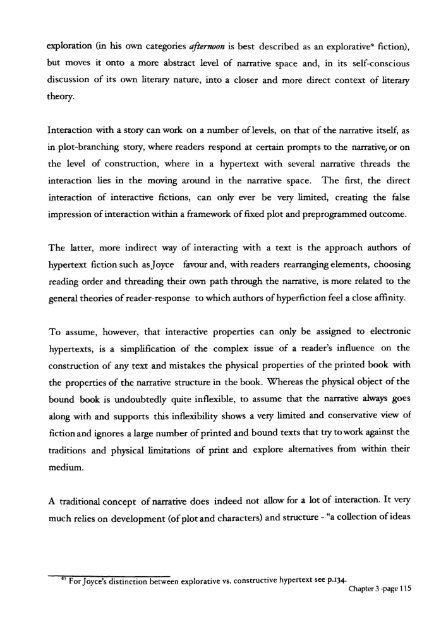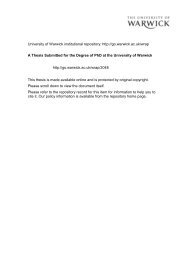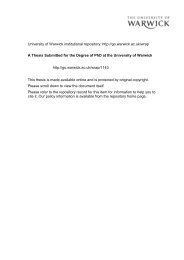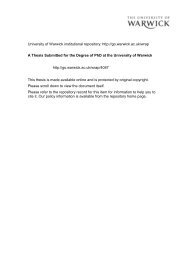From Page to Screen - WRAP: Warwick Research Archive Portal ...
From Page to Screen - WRAP: Warwick Research Archive Portal ...
From Page to Screen - WRAP: Warwick Research Archive Portal ...
Create successful ePaper yourself
Turn your PDF publications into a flip-book with our unique Google optimized e-Paper software.
exploration (in his own categories afternoon is best described as an explorative" fiction),<br />
but moves it on<strong>to</strong> a more abstract level of narrative space and, in its self-conscious<br />
discussion of its own literary nature, in<strong>to</strong> a closer and more direct context of literary<br />
theory.<br />
Interaction with a s<strong>to</strong>ry can work on a number oflevels, on that of the narrative itself, as<br />
in plot-branching s<strong>to</strong>ry, where readers respond at certain prompts <strong>to</strong> the narrative)or on<br />
the level of construction, where in a hypertext with several narrative threads the<br />
interaction lies in the moving around in the narrative space. The first, the direct<br />
interaction of interactive fictions, can only ever be very limited, creating the false<br />
impression ofinteraction within a framework offixed plot and preprogrammed outcome.<br />
The latter, more indirect way of interacting with a text is the approach authors of<br />
hypertext fiction such asJoyce favour and, with readers rearranging elements, choosing<br />
reading order and threading their own path through the narrative, is more related <strong>to</strong> the<br />
general theories ofreader-response <strong>to</strong> which authors ofhyperfiction feel a close affinity.<br />
To assume, however, that interactive properties can only be assigned <strong>to</strong> electronic<br />
hypertexts, is a simplification of the complex issue of a reader's influence on the<br />
construction of any text and mistakes the physical properties of the printed book with<br />
the properties of the narrative structure in the book. Whereas the physical object ofthe<br />
bound book is undoubtedly quite inflexible, <strong>to</strong> assume that the narrative always goes<br />
along with and supports this inflexibility shows a very limited and conservative view of<br />
fiction and ignores a large number ofprinted and bound texts that try <strong>to</strong> work against the<br />
traditions and physical limitations of print and explore alternatives from within their<br />
medium.<br />
A traditional concept ofnarrative does indeed not allow for a lot of interaction. It very<br />
much relies on development (ofplotand characters) and structure - "a collection ofideas<br />
61 For Joyce's distinction between explorative vs. constructive hypertext see P·I34· Chapter 3 -page 115





